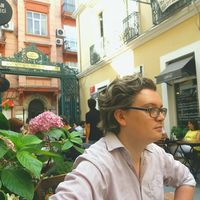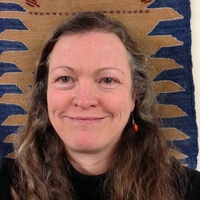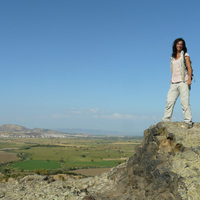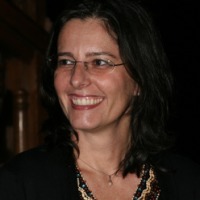
Michael Deniz YILMAZ
Ankara University, Archaeology (BA) 2012
Ondokuz Mayıs University, Archaeology (MA) 2015
Atatürk University, Classical Archaeology (PhD) 2021
İstanbul University, Occupational Safety and Heatlh (AS) 2025
Phone: 03623121919 4691
Address: Ondokuz Mayıs Üniversitesi, İnsan ve Toplum Bilimleri Fakültesi, Arkeoloji Bölümü
55139 Atakum / SAMSUN / TR
Ondokuz Mayıs University, Archaeology (MA) 2015
Atatürk University, Classical Archaeology (PhD) 2021
İstanbul University, Occupational Safety and Heatlh (AS) 2025
Phone: 03623121919 4691
Address: Ondokuz Mayıs Üniversitesi, İnsan ve Toplum Bilimleri Fakültesi, Arkeoloji Bölümü
55139 Atakum / SAMSUN / TR
less
Related Authors
Aneurin Ellis-Evans
University of Oxford
Nerissa Russell
Cornell University
Christina Williamson
University of Groningen
Giusto Traina
Université Paris-Sorbonne (Paris IV)
Alejandra B Osorio
Wellesley College
Sinclair W Bell
Northern Illinois University
Mantha Zarmakoupi
University of Pennsylvania
Enrico Cirelli
Università di Bologna
Annalisa Marzano
Università di Bologna
Florin Curta
University of Florida
InterestsView All (112)










Uploads
Papers by Michael Deniz YILMAZ
A vaulted channel belonging to a Roman Age aqueduct discovered under the foundations of old structures removed during an urban transformation project constitutes the subject of this work. The aqueduct composed of a vaulted channel is located within Gaziosmanpaşa Municipality's Bağlarbaşı District near Adsız Nefer Street and holds important information regarding the aqueducts of İstanbul which began to be utilized to bring water from far destinations. With knowledge from previous research, this work aims to investigate and identify which aqueduct line the channel belongs to and to contribute to the knowledge regarding the city's water supply.
The intention of this paper will be to approach ancient fishing by examining the archaeological material related to the procuring, processing, and production of the aforementioned marine species. It will evaluate the marine species and fishing techniques described in modern Turkish, Greek, and Latin in order to identify the modern definition of these species. It also will aim to establish ancient production techniques. Evidence related to this topic is drawn from ancient writings, archaeological evidences and epigraphic evidences. Consequently, this paper aims to establish the place, techniques, and diversity of fishing in Parion, contributing to the disciplines of archaeology, economy, sociology and biology.
on the Asiatic shore of the Propontis. Today the ancient city is located within the borders of Kemer Village in the Biga Municipality of Çanakkale Province, Turkey. The Parianoi, are known to have rejoiced for hosting a number of famous statues within their city. Information regarding these sculptures is given by ancient authors. Sadly no archaeological evidence of the art work which decorated Parion in antiquity has been found so far. Works fashioned of bronze or marble were created for Parion by renowned Greek sculptors: Hegesias, Euphranor and Praxiteles. In one case, the statue of Eros by Praxiteles, Parian marble was used. In the article, literary evidence regarding the sculptures is examined, combined with evidence from archaeological context of Parion.
Although christianity is a religion which emerged in the 1st century AD it did not immediately reach the mass populace until the religion became the state religion of the Romans in the 4th century AD. The major reason for christianity having been unable to reach the mass populace was the oppression suffered by christianity and followers of the belief: the christians. During and after the period of oppression some people who became martyrs by sacrificing themselves for their belief, or made relative miracles or lived a pius life and thereby set an example for others, were declared “saints”. For each saint there was a commemorative day: this day was either the day of the saints meeting their creator or the day they were declared a saint. It is believed that each saint had some unique powers. The lives and experiences of “saints” are made in to stories and retold along with their powers throughout generations.
Doubtlessly christians worthy of the title “saint” were present in Parion, within this work information regarding these individuals as well as the bishops and archbishops will be presented with some conclusions regarding the christian community of Parion.
This paper aims to establish the ancient knowledge regarding rivers as the source of the water required by the city by referring to ancient geographical and hydrographical information provided by ancient and modern sources for Parion as well as the ancient world.
Parion’s theatre is thought to have been built during the Flavian Period in the late 1st century AD and was altered/renovated several times during the second half of the 2nd century and the early 3rd century AD. Having water discharge related components installed in the orchestra, hyposcaeneium and the versura suggests that Parion’s theatre was used as a multi-functional theatre. A further hint of the theatre being a multi-funtional entertainment structure is the gladiatorial combat and venatio (beast combat and displays) related graffiti.
This work intends to introduce the water system of the theatre of Parion and evaluate the system along with some architectural aspects of the theatre. Understanding the purpose of these water systems with regard to theatrical spectacles is another intent of this work.
A vaulted channel belonging to a Roman Age aqueduct discovered under the foundations of old structures removed during an urban transformation project constitutes the subject of this work. The aqueduct composed of a vaulted channel is located within Gaziosmanpaşa Municipality's Bağlarbaşı District near Adsız Nefer Street and holds important information regarding the aqueducts of İstanbul which began to be utilized to bring water from far destinations. With knowledge from previous research, this work aims to investigate and identify which aqueduct line the channel belongs to and to contribute to the knowledge regarding the city's water supply.
The intention of this paper will be to approach ancient fishing by examining the archaeological material related to the procuring, processing, and production of the aforementioned marine species. It will evaluate the marine species and fishing techniques described in modern Turkish, Greek, and Latin in order to identify the modern definition of these species. It also will aim to establish ancient production techniques. Evidence related to this topic is drawn from ancient writings, archaeological evidences and epigraphic evidences. Consequently, this paper aims to establish the place, techniques, and diversity of fishing in Parion, contributing to the disciplines of archaeology, economy, sociology and biology.
on the Asiatic shore of the Propontis. Today the ancient city is located within the borders of Kemer Village in the Biga Municipality of Çanakkale Province, Turkey. The Parianoi, are known to have rejoiced for hosting a number of famous statues within their city. Information regarding these sculptures is given by ancient authors. Sadly no archaeological evidence of the art work which decorated Parion in antiquity has been found so far. Works fashioned of bronze or marble were created for Parion by renowned Greek sculptors: Hegesias, Euphranor and Praxiteles. In one case, the statue of Eros by Praxiteles, Parian marble was used. In the article, literary evidence regarding the sculptures is examined, combined with evidence from archaeological context of Parion.
Although christianity is a religion which emerged in the 1st century AD it did not immediately reach the mass populace until the religion became the state religion of the Romans in the 4th century AD. The major reason for christianity having been unable to reach the mass populace was the oppression suffered by christianity and followers of the belief: the christians. During and after the period of oppression some people who became martyrs by sacrificing themselves for their belief, or made relative miracles or lived a pius life and thereby set an example for others, were declared “saints”. For each saint there was a commemorative day: this day was either the day of the saints meeting their creator or the day they were declared a saint. It is believed that each saint had some unique powers. The lives and experiences of “saints” are made in to stories and retold along with their powers throughout generations.
Doubtlessly christians worthy of the title “saint” were present in Parion, within this work information regarding these individuals as well as the bishops and archbishops will be presented with some conclusions regarding the christian community of Parion.
This paper aims to establish the ancient knowledge regarding rivers as the source of the water required by the city by referring to ancient geographical and hydrographical information provided by ancient and modern sources for Parion as well as the ancient world.
Parion’s theatre is thought to have been built during the Flavian Period in the late 1st century AD and was altered/renovated several times during the second half of the 2nd century and the early 3rd century AD. Having water discharge related components installed in the orchestra, hyposcaeneium and the versura suggests that Parion’s theatre was used as a multi-functional theatre. A further hint of the theatre being a multi-funtional entertainment structure is the gladiatorial combat and venatio (beast combat and displays) related graffiti.
This work intends to introduce the water system of the theatre of Parion and evaluate the system along with some architectural aspects of the theatre. Understanding the purpose of these water systems with regard to theatrical spectacles is another intent of this work.
Although christianity is a religion which emerged in the 1st century AD it did not immediately reach the mass populace until the religion became the state religion of theRomans in the 4th century AD. The greatest reason for christianity having been unable to reach a mass populace was the oppression suffered by christianity and followersof the belief: the christians. During and after the period of oppression some people who became martyrs by sacrificing themselves for their belief, or made relativemiracles or lived a pius life and thereby set an example for others, were declared “saints”. For each saint there was a commemorative day: this day was either the day of the saints meeting their creator or the day they were declared a saint. It is believed that each saint had some unique powers. The lives and experiences of “saints” aremade in to stories and retold along with their powers throughout generations.
Doubtlessly christians worthy of the title “saint” were present in Parion, within this work information regarding these individuals will be presented with some conclusions regarding the christian community of Parion
The intention of this paper will be to approach ancient fishing by the archaeological material related to the procuring, processing and production of the aforementioned marine food species along with evaluating the species and techniques used with the modern Turkish and Greek terminology and techniques of fishing in order to establish the species known to mankind today, together with establishing the production techniques. Material regarding this paper are the ancient writings, archaeological evidences and epigraphic evidences related to the topic. Consequently this paper is aimed to establish the place, techniques and diversity of fishing in Parion; regarding the disciplines of archaeology, economy, sociology and biology.
ruhsatnamesine göre Parion kazısı 2016 yılı çalışmaları, 12
akademisyen, 9 arkeolog, 2 mimar, 8 restoratör- konservatör, 23 arkeoloji
öğrencisi ve 18 işçiden oluşan bir ekip tarafından, 13 Temmuz- 06 Eylül
2016 tarihleri arasında Bakanlığımıza sunulan kazı programı çerçevesinde,
güney nekropolis, tiyatro, odeion, Roma hamamı, yamaç hamamı, agora ve
dükkânlar, su kemeri, su kuyusu 1, oda mezarlar ve mozaikli yapı olmak
üzere, antik kentin 10 ayrı bölgesinde gerçekleştirilmiş olup, 487 kalem etütlük
ve 15 adet envanterlik eser ortaya çıkarılmıştır.
sonucunda boru hattının tamiri sırasında, birisi Klasik Döneme ikisi ise
Hellenistik Döneme tarihli toplam üç adet lahit mezar ele geçmiştir. Söz konusu
lahitlerin çıktığı bölgede Çanakkale Arkeoloji Müzesi uzmanları kurtarma kazısı
gerçekleştirmiştir. Lahitlerin ele geçtiği parsel Parion Antik Kenti sit sınırlarının
yaklaşık olarak 100 m dışında kalmaktadır. Bu durumun sonuncunda kazı
başkanlığı olarak sit sınırların yeniden irdelenmesi ve kentin arkeojeofizik
haritasının çıkartılmasının için bu çalışma gerçekleştirilmiştir